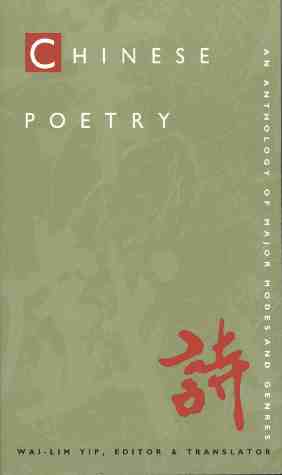Buy from Amazon.com

First a note on the format of the book. The subtitle is important: "An Anthology of Major Modes and Genres". This is the theme which governs the organisation of the material: the poems are grouped by form rather than by poet. There is a contents list for the poems, but no indexing by author or title, so the book seems to be aimed at those who will like what they are given rather than those who know what they are looking for.
Wai-lim Yip is Chinese poetry's equivalent of the period instrument zealots of classical music. He produced this collection in the 1970s in what he calls "dismay and anger" at what he sees as the "gross distortions" of Chinese poems by the old school translators of the 19th and early 20th centuries.
Yip's argument is essentially that Chinese poetry is characterised by the juxtaposition of images; that the relationships between these images are the more expressive for being left unsaid; and that when they are spelt out by the insertion by translators of prepositions, conjunctions and pronouns, the productive ambiguity of these relationships is lost.
Thus far, Yip is absolutely right, but it is in his attempts to apply this argument to the practice of translation that he goes wrong. Firstly, his introductory essay is devoted largely to raising and destroying men of straw: the examples of "gross distortion" which he produces are from forgotten translators of a pre-modernist period and aesthetic, which differs as much from contemporary translations as it does from the Chinese viewpoint. He never takes on respected translators such as Waley, let alone those working in the 70s or today.
The second problem is that he fails to realise that the filling in of prepositions and other syntactic helpers is the result not of misunderstanding Chinese, but of understanding English. English translations need these words because that is the way that the English language expresses relationships; where they are omitted, we have good Chinese but bad English. Word for word translations such as Yip's are "half translations": helpful cribs for reading the original, but nothing more. Yip's failure to appreciate this shows the dangers of attempting to translate into, rather than from, a foreign language.
Yip attempts to circumvent this difficulty by pointing to poets of the modernist period, particularly Pound, who produced this kind of work under the influence of Chinese and Japanese poetry. But he fails to see that these are Orientalist works of the early 20th century, rather than signs of a lasting change in the English language or in the western aesthetic. Translating Du Fu and Li Bai as if they were Ezra Pound merely reinforces their apparent strangeness, rather than helping us to understand them.
As an example, Yip's Chun Wang is as follows:
Spring Scene
All ruins, the empire; mountains and rivers in view.
To the city, spring: grass and trees are thick.
The times strike. Before flowers, tears break loose.
Separation cuts. Birds startle our heart.
Beacon fires continued for three months on end.
A letter from home is worth thousands of gold pieces.
White hair, scratched, becomes thinner and thinner,
So thin it can hardly hold a pin.
In this translation, Yip's determination not to spell out the relationship between the elements leads him to deny their relationships. The translation of each line as one or more complete sentences, for example, destroys the couplets which are the main structural element of the poem. He can only avoid clarifying the relationship between the city and spring in the second line by producing a phrase with no meaning at all ("To the city, spring").
So Yip's translations fail as English poems. He replaces the implied connections of the original only with disconnections. But where the book does succeed is as a learning tool: the most valuable version of each poem is not the translation itself but the word for word crib which precedes it. This, coupled with the reasonably legible calligraphic Chinese text, is a great help for students of Chinese wishing to understand the original. This, then, is not a book for those seeking English translations, but it is an excellent resource for the student of the language.
Postscript: thanks to Paul Albert for the following opposing view:
I find the approach the first fundamental breakthrough in crosscultural contextualization that attempts to bring chinese culture to life for the western mind.
This attempt reaches past the analytic perspective and borders on a cultural anthropology of mind. This is of keen value to psychologists, who began a primitive study in the late 1880's under the direction of Wundt. It went no further than 1900.
Besides the importance for linguists, those inspired by ancient texts, translators, students of comparative religion and traditional chinese medicine, the breakthough in the realm of poetry is attempted with a boldness that affirms the host cultural fabric as enlivened by the members of the historical community. This, to me, places the text in the forefront of a new begining.
Buy from Amazon.com
